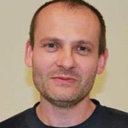Automated nucleic acids isolation using paramagnetic microparticles coupled with electrochemical detection.
Ключові слова
Анотація
Easy, efficient and low demanding separation of mRNA from biological material is needed to study gene expression and to use in chip technologies. It is common knowledge that each mRNA molecule contains sequence of 25 adenines. This feature can be used for binding mRNA on the surface of the particles coated by thymine chains. The present work reports on suggesting and optimizing of mRNA separation and detection from biological material via paramagnetic microparticles coupled with electrochemical detection. Primarily we optimized cyclic and square wave voltammetric conditions to detect poly(A), which was used as standard to mimic behaviour of mRNA. Under the optimized square wave voltammetric conditions (frequency 280 Hz, accumulation time 200 s, supporting electrolyte and its temperature: acetate buffer 4.6 and 35 degrees C) we estimated detection limit down to 1 ng of poly(A) per ml. To enhance effectiveness and repeatability of isolation of nucleic acid automated approach for rinsing and hybridizing was proposed. We optimized the whole procedure and experimental conditions. Using automated way of isolation and under optimized conditions the yield of poly(A) (isolated concentration of poly(A)/given concentration of poly(A)*100) was approximately 75%. The suggested and optimized method for poly(A) isolation and detection was utilized for the analysis of brain tissues of patients with traumatic brain injury. The total amount of isolated mRNA varied from 40 to 760 g of mRNA per g of brain tissue. The isolation of mRNA from six samples per run was not longer than 2.5h. Moreover, we applied the optimized procedure on fully automated pipetting instrument to isolate mRNA. The instrument was successfully tested on the analysis of extracts from roots of maize plants treated with cadmium(II) ions.




